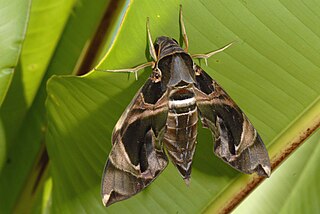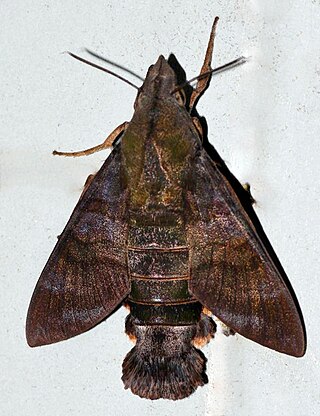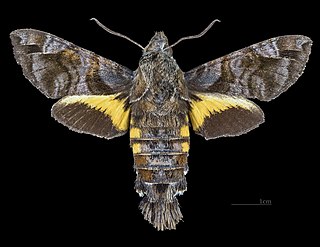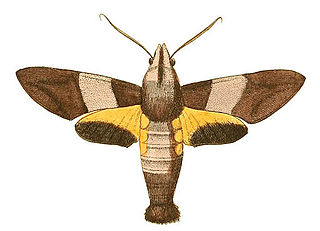
Acherontia styx, the lesser death's head hawkmoth or bee robber, is a sphingid moth found in Asia, one of the three species of death's-head hawkmoth. It is very fond of honey, and bee keepers have reported finding dead moths in their hives as a result of bee stings. They can mimic the scent of bees so that they can enter a hive unharmed to get honey. Their tongue, which is stout and very strong, enables them to pierce the wax cells of the beehive and suck the honey out. They are also known to be a pest of yuzu in South Korea, using their tongue to pierce and damage the fruit.

Nephele hespera, the crepuscular hawkmoth, is a sphingid moth described by Johan Christian Fabricius in 1775.

Daphnis hypothous, the jade hawkmoth, is a species of moth in the family Sphingidae described by Pieter Cramer in 1780. It is known from Sri Lanka, India, Nepal, Myanmar, southern China, Taiwan, Thailand, Malaysia, and Indonesia. It is a rare vagrant to the Western Palaearctic realm. During the last hundred years a number have been discovered within the Middle East and one was even found in Scotland late in the 20th century but this was probably imported as a pupa with cargo.

Theretra silhetensis, the brown-banded hunter hawkmoth, is a moth of the family Sphingidae described by Francis Walker in 1856. It lives in Indo-Australia, India, Sri Lanka, Papua New Guinea, East Australia, Solomon Islands, Fiji Islands, Vanuatu Islands.

Cephonodes hylas, the coffee bee hawkmoth, pellucid hawk moth or coffee clearwing, is a moth of the family Sphingidae. The species was first described by Carl Linnaeus in 1771. A widely distributed moth, it is found in the Near East, Middle East, Africa, India, Sri Lanka, Japan, Southeast Asia and Australia.

Hippotion velox, the dark striated hawkmoth, is a species of sphingid moth or the family Sphingidae. The species was described by Johan Christian Fabricius in 1793.

Macroglossum affictitia, the dark-bordered hummingbird hawkmoth, is a moth of the family Sphingidae. It is known from Sri Lanka and southern India to Myanmar, Thailand and south-western Yunnan, China. It was described by Arthur Gardiner Butler in 1875.

Macroglossum belis, the common hummingbird hawkmoth, is a moth of the family Sphingidae. It was described by Carl Linnaeus in his 1758 10th edition of Systema Naturae. It is known from Sri Lanka, India, Nepal, Thailand, southern China, Taiwan, Japan, Vietnam and Indonesia (Java).

Macroglossum corythus is a species of hawk moth of the family Sphingidae. It was described by Francis Walker in 1856 and is found throughout the Indo-Australian tropics east to New Caledonia.

Macroglossum glaucoptera, the dark hummingbird hawkmoth, is a moth of the family Sphingidae. It was described by Arthur Gardiner Butler in 1875. It is known from Sri Lanka, Thailand, southern China, Vietnam, Malaysia (Peninsular), Indonesia and the Philippines (Mindanao). Single specimen recorded from Papua New Guinea.

Macroglossum gyrans is a moth of the family Sphingidae. It was described by Francis Walker in 1856 and is known from South-east Asia and Madagascar.

Macroglossum insipida, the hermit hummingbird hawkmoth, is a moth of the family Sphingidae. It was described by Arthur Gardiner Butler in 1875.

Macroglossum mitchellii, the grey-striped hummingbird hawkmoth, is a moth of the family Sphingidae described by Jean Baptiste Boisduval in 1875. It is known from Sri Lanka, southern and eastern India, Thailand, southern China, Taiwan, Vietnam, Malaysia and Indonesia.

Macroglossum passalus, the black-based hummingbird hawkmoth, is a moth of the family Sphingidae described by Dru Drury in 1773. It is known from Sri Lanka, India, Thailand, south-eastern China, Taiwan, southern Japan, Indonesia and the Philippines.

Macroglossum pyrrhosticta, the maile pilau hornworm or burnt-spot hummingbird hawkmoth, is a hawk moth of the family Sphingidae. The species was first described by Arthur Gardiner Butler in 1875.

Macroglossum sitiene, the crisp-banded hummingbird hawkmoth, is a moth of the family Sphingidae described by Francis Walker in 1856.

Pergesa is a monotypic moth genus in the family Sphingidae first described by Francis Walker in 1856. Its only species, Pergesa acteus, the green pergesa hawkmoth, was described by Pieter Cramer in 1779.

Acosmeryx shervillii, the dull forest hawkmoth, is a moth of the family Sphingidae. The species was first described by Jean Baptiste Boisduval in 1875. It is found from the Indian subregion, Sri Lanka, to Sundaland, the Philippines and Sulawesi. Acosmeryx pseudonaga is sometimes treated as a valid species.

Marumba spectabilis, the rosey swirled hawkmoth, is a moth of the family Sphingidae. The species was first described by Arthur Gardiner Butler in 1875.





















